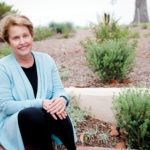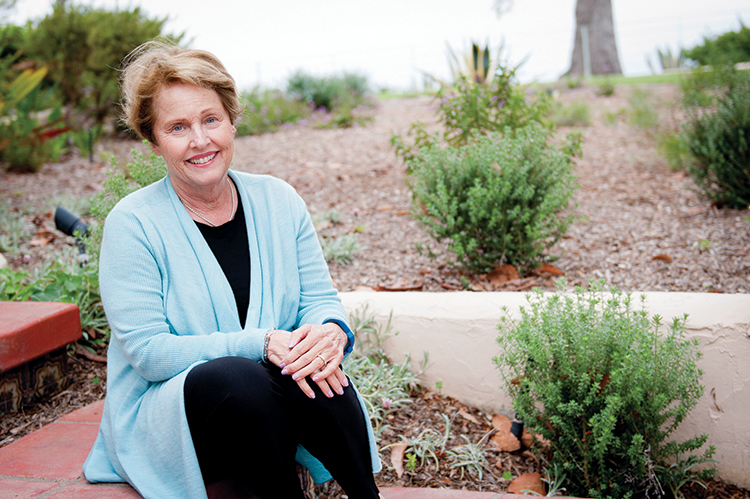By LAUREL BUSBY
Staff Writer
 California’s drought has made Los Angelenos change the way they think about water, and that’s a good thing, water expert Fran Diamond said.
California’s drought has made Los Angelenos change the way they think about water, and that’s a good thing, water expert Fran Diamond said.
Residents and businesses have already replaced 27 million sq. ft. of landscaping as of February, said Diamond, a 16-year member of the L.A. Regional Water Quality Board, a state agency that regulates water quality for Los Angeles and Ventura counties.
In her own Pacific Palisades home, Diamond has installed drip irrigation and also a rain barrel to catch siphoned rainwater from her roof for her Moreton Bay fig tree. She also pulled out her front lawn, put in drought-resistant plants, and planted new grass plugs that will take over the remaining lawn and require much less water, so her grandchildren can enjoy a smaller, drought-tolerant lawn.
“We have the capacity to rise to the occasion,” Diamond said. “People have been doing it. They’ve heard the call to action by the governor and the water-quality regulators and just through wanting to be smart and helpful. It’s been a really good education for everybody. People have been amazing in terms of trying to be part of the solution.”
Within the government, various changes have been happening since the five-year drought began. Although rainfall and snowfall improved this winter, the drought is still present, and the state required an average cutback of about 25 percent on water consumption last year, Diamond said.
The entire Los Angeles populace is learning to rethink water use. One of the big changes involves not thinking of water as separate parts, such as storm water and wastewater. Instead, the idea is to consider all water as one water that is retained and reused, so that the metro area becomes water independent by gradually relying less on water imported from distant sources, which costs 50 to 60 percent more.
For example, storm water and wastewater are highly treated at various facilities, such as the Hyperion Treatment Plant, and then this water, averaging about 400 million gallons per day, is released into the ocean.
“We take that highly treated water and dump it into the ocean. We need to develop technologies to take that water for reuse,” said Diamond, who first began tackling environmental issues in 1968 along with her husband, Roger, via the 20-year No Oil! campaign, which eventually resulted in a ban against onshore oil drilling in Los Angeles (including land east of Temescal Canyon in the Palisades). “We need to stop dumping all of that water after spending millions of dollars to treat it.”
L.A. city government started prioritizing water issues under Mayor Antonio Villaraigosa and is continuing to address them under Eric Garcetti, Diamond said. Part of the issue is funding, but voters have approved some funding that is being used for varied projects both locally and in other parts of the state.
For example, Proposition 1 in 2014 provided $7.1 billion to address water issues, and approximately $3 billion of the funds are slated to increase water storage capability both above and below ground, so water can be captured and reused, Diamond said.
In addition, $500 million is targeted for water-quality improvements from Proposition O, which was passed by 76 percent of voters in 2004. Via this funding, varied systems to divert storm water for treatment, including one at PCH and Temescal, have been installed to affect the millions of gallons of water that come through the storm system even on dry days, Diamond said.
“The City of L.A. is actually doing a really good job,” said Diamond, who noted that the second phase of Prop. O involves projects to reuse the water. “Storm water will be disinfected and used for landscaping. There are lots of projects all over. Some are fantastic projects that have brought great amenities.”
For example, Echo Park Lake opened in 2013 after a project cleaned up and drained the lake’s uncirculated, poor-quality water and then installed a system to clean and circulate the water, creating a usable wetlands and lake in an area with few park amenities. Smaller projects include one downtown on Grand Avenue, where storm-water filters from about seven acres accumulate water, treat it and then use it to provide water for Grand Park tree wells.
“We have enough water, but we don’t have enough to waste,” said Diamond, who moved to Pacific Palisades with her husband in 1968. “I think it’s not an exaggeration to say that there’s a whole revolution taking place in water policy now because of drought and climate change.
“Part of this revolution is becoming water independent, because we need to. The amount of water we have relied on from importing is no longer available to us. I think people are up to it,” she said. “People are responding to the crisis.”
Longtime Palisadian Fran Diamond. Photo: Lesly Hall












You must be logged in to post a comment.